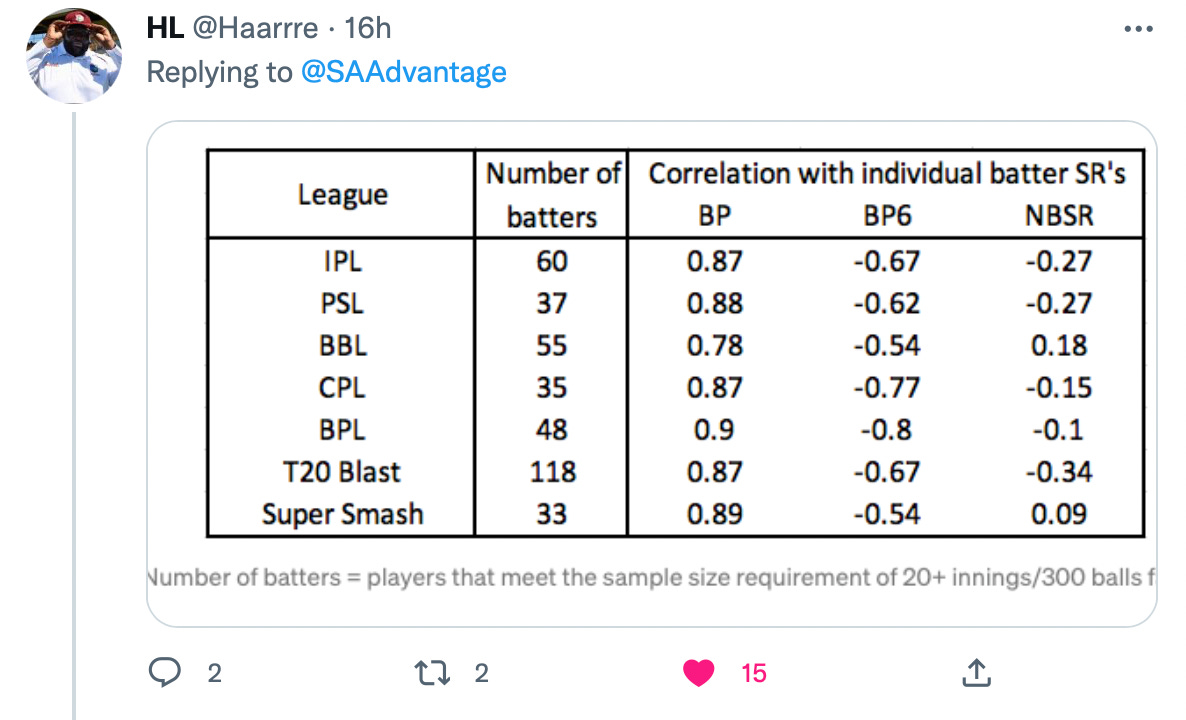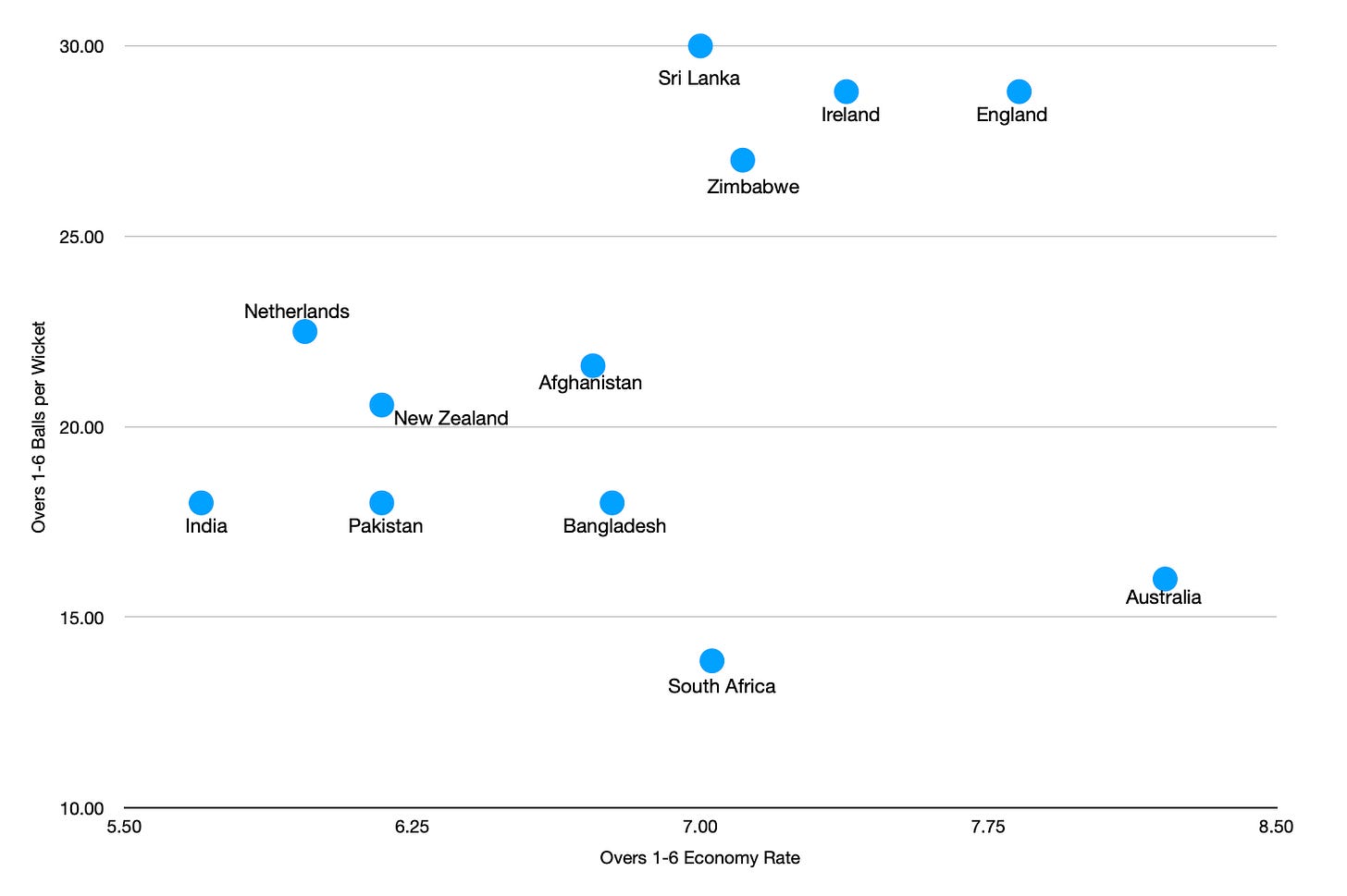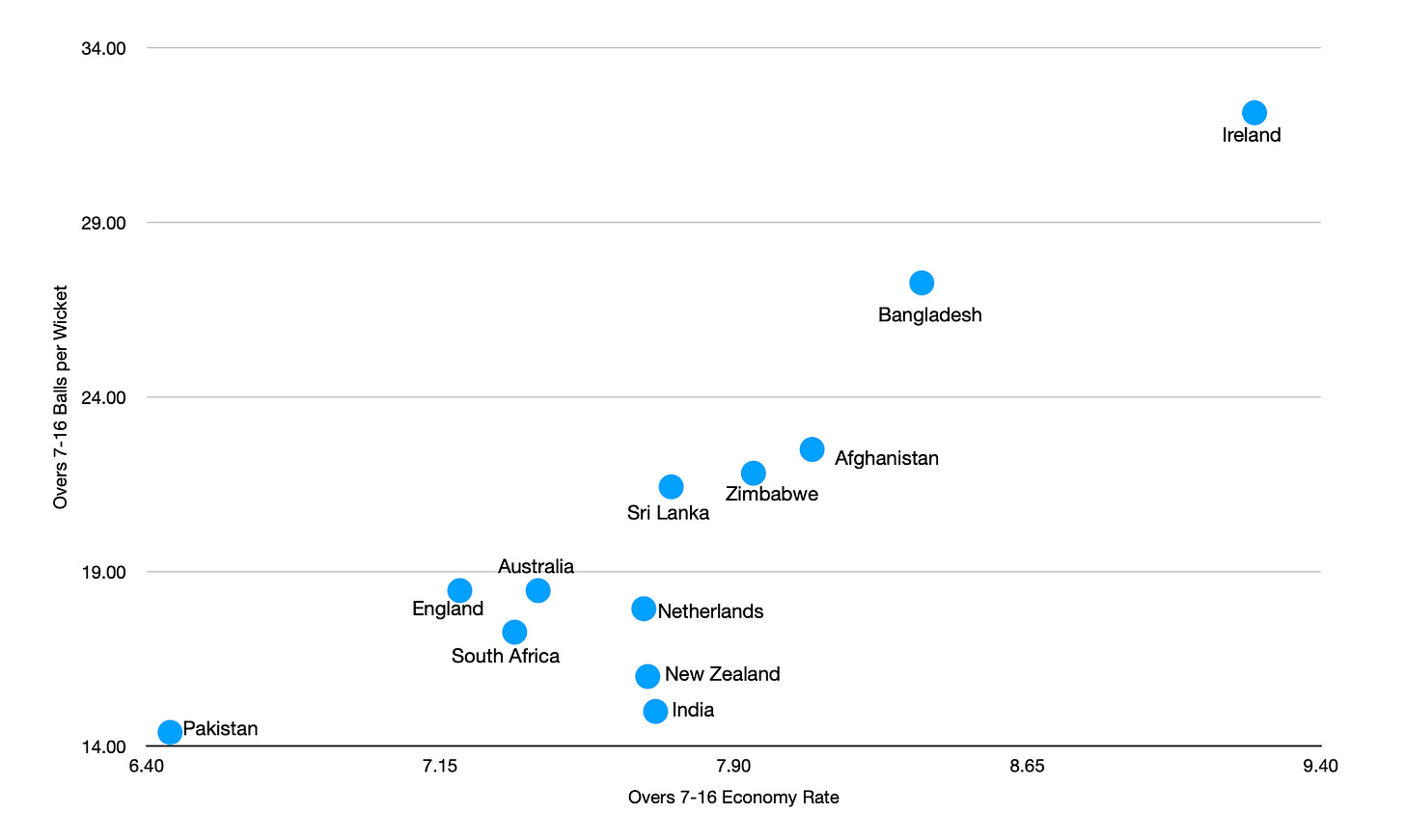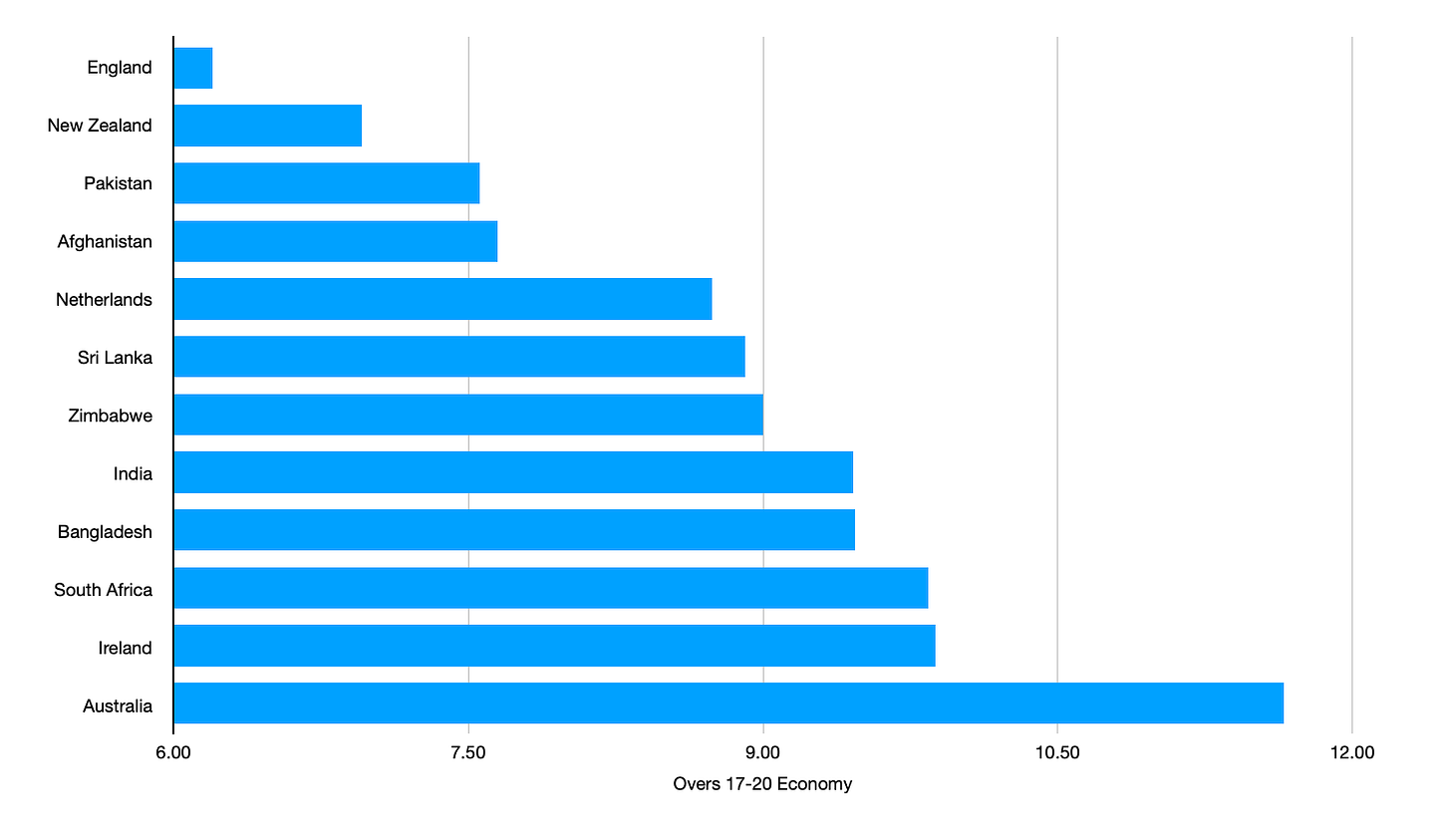With the first semi-final of the T20 World Cup taking place tomorrow, what better time can there be to do a deep dive into some team data for the tournament so far?
First up, some general data which I tweeted last night:-
First up, 80% of boundary % winners winning the match doesn’t sound very low, but it is - usually most tournaments are up into the high 80%s, and it’s not totally unheard of for an entire tournament to have only 0-2 non-boundary % winners winning the match across the whole event.
With 89% of matches so far in this World Cup being decided by winning the dot ball percentage, there are perhaps some different drivers of success here in Australia compared to other venues. We know that in Australia, boundaries tend to be bigger, and posting a ‘competent’ score appears to have slightly more value there than in other countries.
Of course, all this could be variance - we still only have a sample size well below 50 matches - but some interesting research from @Haarrre on Twitter showed that there’s a fairly similar dynamic in the Big Bash (Australia’s domestic league) as well:-
You’ll see from his numbers that there’s less of a correlation in the BBL for BP (Boundary Percentage) than the other leagues, and more of a correlation with NBSR (Non-Boundary Strike Rate), so it would appear to be a trend in Australia - boundary-hitters who dot up more than average as well are likely to have a little less positive impact than they would in other countries. Of course, there’s nothing wrong with being a strong boundary-hitter and a good non-boundary run producer too, but only elite batters can manage that!
There are often small sample sizes involved, but let’s move on to team performance. First up, there’s almost always a huge correlation between net boundary percentage (batting boundary % - bowling boundary %) and qualification in T20 tournaments, so who led the net boundary percentage charts:-
South Africa could consider themselves rather unfortunate not to qualify - although there will be plenty of people who consider there to be a different narrative - while the next three teams all qualified. England, ranked 7th for net boundary percentage, have disappointed so far despite qualifying and haven’t dominated as many will have anticipated. Let’s see if they can turn these numbers around in the knockout stages.
Team batting/bowling boundary percentages are also interesting to look at:-
England’s issues have stemmed from poor boundary production with the bat, although their bowling has been FAR better than I think anyone would have anticipated. The development of Sam Curran into a death bowler has obviously helped in this respect. However, I don’t think anyone would have predicted they’d be in the bottom-left of this chart (poor batting, good bowling) prior to the tournament.
Australia’s failure to qualify in a home tournament has obviously attracted plenty of criticism and despite having the second-highest batting boundary percentage, they actually conceded the highest boundary percentage in the Super 12s - giving them plenty to contemplate in terms of how they evolve their bowling group. Pakistan had rather the reverse dynamic, with magnificent boundary prevention with the ball, but uninspiring boundary production with the bat.
The other thing worth noting here is how low these boundary percentages are. In many tournaments, around 16.5-17% boundaries are average, and you can see that in the Super 12s so far, ball has dominated bat and only South Africa were able to get past that 17% boundary-hitting percentage (just) in the tournament so far. Again, this is the effect of big boundaries and perhaps also some often used pitches.
Has spin or pace been more effective so far in the tournament?
Pace has been far more effective, considering the higher scoring phases in which generally operates in. For batters to be striking at a similar rate against pace and spin illustrates the difficulty with which many batters have had facing high quality pace in the tournament so far - but although pace has been much more effective, spin still has had it’s part to play. The big boundaries and used pitches have seen to that.
There is also a clear polarisation between pace and spin team performance:-
New Zealand, India and England were closest to the ideal top-right corner - being strongest vs opposition pacers, while it’s interesting to note several other things too. Firstly, Ireland impressed vs opposition pacers compared to their finishing position, while Australia struggled. Is there any coincidence that the non-India subcontinent teams also produced mediocre numbers vs pace bowling, given the unfamiliar conditions on display in Australia? Pre-tournament expectations in this area were low for Netherlands and Zimbabwe, which manifested itself in reality also.
For England, though, things turn ugly when looking at performance against opposition spinners:-
England - the team with the big-hitting reputation - have failed miserably against opposition spinners so far in the tournament, striking at below 100 and averaging barely above 20.
This leads to several interesting selection debates with regards to their semi-final against India on Thursday - could India look to bring in Yuzvendra Chahal to further test the England batters? And should Dawid Malan be injured, could England look to injury replace him with Ben Duckett - a left-hander who is 1) one of the best players of spin in England in T20, and 2) perfectly suited to the non-boundary run production bias of Australia. If possible, this is what I would do as opposed to just pick Phil Salt instead - this is not like for like (Salt - ultra-attacking RHB, Malan - anchor LHB) and would be like a football team having an injured defensive midfielder and replacing them with an attacking midfielder who doesn’t track back.
As the batting analysis continues, a look at phase performance in the Super 12s. Here’s overs 1-6:-
Only half the teams in the tournament were able to strike at 110+ in a phase which tends to be much higher scoring due to the field restrictions. I think there’s a nod here to how tough it’s been to bat in the Powerplay due to conditions, but also this can be partly explained by a lack of intent and execution of attacking shots - with India, Pakistan and Australia notable teams in this respect.
Moving on to the middle overs:-
This is such a strange dynamic. The conservatism of the Powerplay has been replaced with more intent in the middle overs, which isn’t usually the case in T20 leagues. New Zealand, Australia and India are ahead of the rest in middle overs performance in the Super 12s, with England having a really tough time of it. On a (reported to be) used pitch on Thursday, India really should strongly consider giving England a big test of spin - leaving out Shami for Chahal could be a really strong opposition-specific selection.
Continuing the theme of strange dynamics - here’s the death overs strike rate for each team:-
Only three teams struck at 135+ at the death in the Super 12s - India, New Zealand and Pakistan - with both India and Pakistan looking to lay a platform to attack in this phase. Whether India can replicate this if Suryakumar Yadav gets out cheaply is another debate. Of the more higher-profile nations, England, South Africa and Australia really struggled with their death hitting in the group stages, while Bangladesh and Sri Lanka’s notable (and predictable) lack of power hitters sees them towards the bottom of death over strike rate performance.
Onto bowling now, here’s a look at phase performance for each team. Overs 1-6 to start with:-
India and Pakistan were the most impressive Powerplay bowling units in the group stage - probably not a huge surprise to anyone who has watched the matches - while South Africa took wickets at an absurdly quick rate, but traded that off with worse run prevention. Australia were an even more extreme version of this. England struggled in this phase so far, struggling to both take wickets and stem the flow of opposition runs in the Powerplay.
Also - a shout out to Netherlands. They rated really well for Powerplay bowling, outperforming many Test-playing nations and the likes of Freddie Klaassen, Paul van Meekeren and Brandon Glover did a strong job for them, enhancing their reputations in the tournament.
Now, here’s overs 7-16:-
The next step in Ireland’s development as an improving T20 nation is to try and develop a high quality spinner to hold down these middle overs more effectively, while Bangladesh’s over-reliance on left arm orthodox spinners is well known - as well as power hitters, they really need to look to develop wrist spinners.
Pakistan’s bowling performance in the middle overs is nothing short of stunning, and will be a big part of their semi-final against New Zealand on Wednesday. Quite incredibly, they conceded below 2% sixes in this phase in the Super 12s. England, South Africa, Australia and India were also among those whose bowling attacks impressed in the middle overs in the group stage.
Finally, to the last four overs bowling performance, and an eye-opener:-
Australia, at home, had the worst economy rate in the death overs by an absolute mile - it’s not difficult to anticipate Nathan Ellis getting a call from the selectors in the near future to reinforce their death bowling attack.
The top three performing death bowling teams all qualified, with England - led by Sam Curran - topping the charts. It would have been difficult to predict that in advance of the tournament! The strong bowling attacks of New Zealand (even without selecting Adam Milne) and Pakistan were rather more predictable, and again they showed their quality here.
So, onto the semi-finals. Firstly, New Zealand vs Pakistan - battle of two very high quality pace attacks. Both teams have only one or two batters who can take it away from the opposition. I give Pakistan the edge, around 55/45, but you can never rule out a New Zealand team who so often perform to a level greater than the sum of their parts.
I make India favourites against England in the second semi-final, probably similar in terms of expected percentages, or maybe a couple of percentage points further in favour of India. I worry about England’s batting against spin, which I think will be the main determinant in this clash - both teams need to be smart with their selection decisions (far from a given) and I expect the team who plays the opposition spinners best will win the match.
















Really interesting as always. Do you think England's weakness against spin is a whole team thing or is it because they've had the wrong players facing the majority of the ball bowled by spinners?